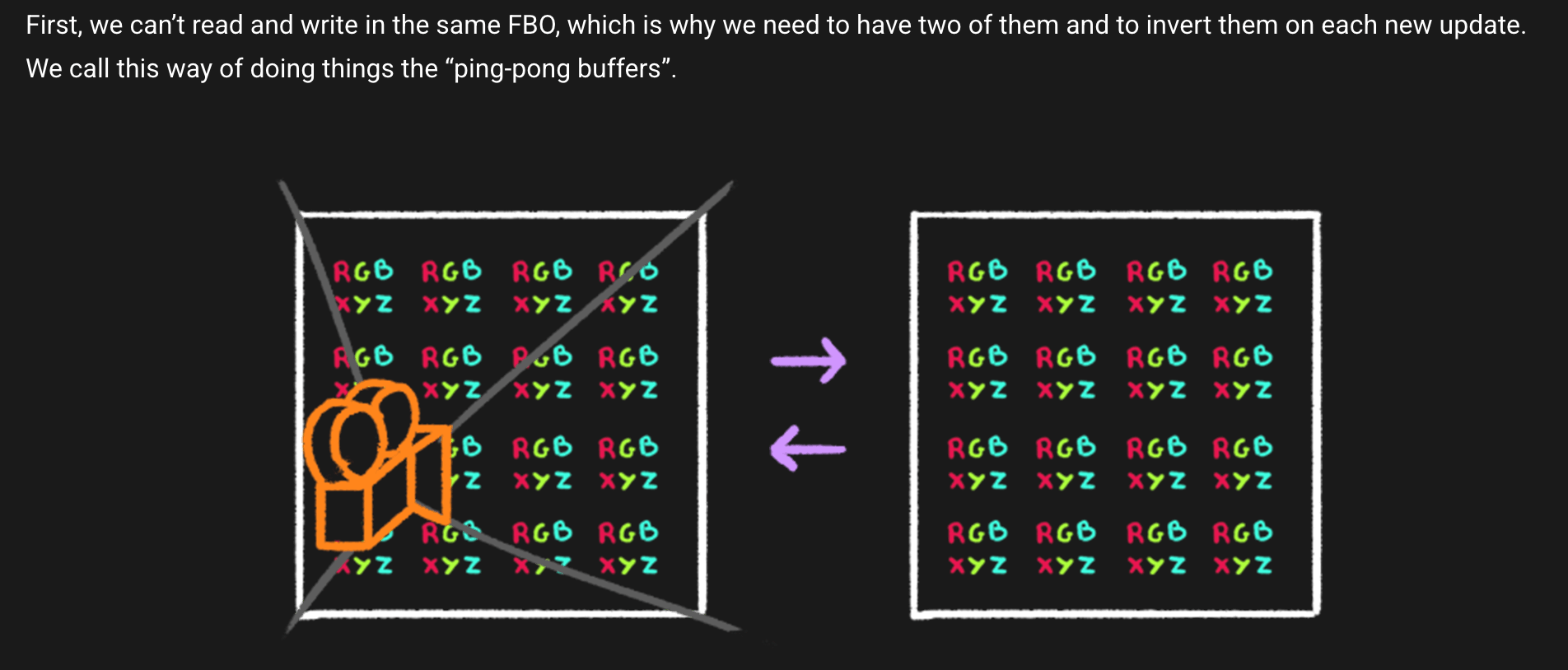
GPGPU
GPGPU
So to pick up where I left off, I want to understand how Frame Buffers and Ping-ponging works to be able:
- compare it with WGSL compute shaders
- work on my Memories Room no. 2
So, we have a texture in our Frame Buffer Object which we can use for our vertices position instead of simply rendering it, like we would do normally. Because we can not read and write to the same Frame Buffer Object at the same time, we will update it and then exchange them to each other (ping-ponging):

I feel that the most challenging thing will be to do the setup myself, as Bruno Simon’s tutorial provided quite a ready solution with GPUComputationRenderer:
/**
* GPU Compute
*/
//Setup
const gpgpu = {}
gpgpu.size = Math.ceil(Math.sqrt(baseGeometry.count))
gpgpu.computation = new GPUComputationRenderer(gpgpu.size, gpgpu.size, renderer) //square: width , height
//Base particles
const baseParticlesTexture = gpgpu.computation.createTexture()
for (let i = 0; i < baseGeometry.count; i++) {
const i3 = i * 3
const i4 = i * 4
// Position based on geometry
baseParticlesTexture.image.data[i4 + 0] = baseGeometry.instance.attributes.position.array[i3 + 0]
baseParticlesTexture.image.data[i4 + 1] = baseGeometry.instance.attributes.position.array[i3 + 1]
baseParticlesTexture.image.data[i4 + 2] = baseGeometry.instance.attributes.position.array[i3 + 2]
baseParticlesTexture.image.data[i4 + 3] = Math.random()
}
console.log(baseParticlesTexture)
//Particles variable
gpgpu.particlesVariable = gpgpu.computation.addVariable('uParticles', gpgpuParticlesShader, baseParticlesTexture)
gpgpu.computation.setVariableDependencies(gpgpu.particlesVariable, [gpgpu.particlesVariable]) //you can pass more dependencies here
// Uniforms
gpgpu.particlesVariable.material.uniforms.uTime = new THREE.Uniform(0)
gpgpu.particlesVariable.material.uniforms.uDeltaTime = new THREE.Uniform(0)
gpgpu.particlesVariable.material.uniforms.uBase = new THREE.Uniform(baseParticlesTexture)
gpgpu.particlesVariable.material.uniforms.uFlowFieldInfluence = new THREE.Uniform(0.5)
gpgpu.particlesVariable.material.uniforms.uFlowFieldStrength = new THREE.Uniform(2.0)
gpgpu.particlesVariable.material.uniforms.uFlowFieldFrequency = new THREE.Uniform(0.5)
//Init
gpgpu.computation.init()
I will look into its code more closely tomorrow, as Bruno mentioned, it’s a good thing that it’s well-documented.
Following the tutorial, we saved all vertices for our particles positions in a texture which was update using shader, and then retrieved this texture in our actual vertex shader. Another thing for me to keep in mind that I am kind of used to having a lot of built-in things in shaders such as modelMatrix and viewMatrix and I am not sure you have them in WGSL (will see soon!).
Tweaks
Okay, we have a nice result, let’s play with it just a little bit for now, and then also get back to it later!
First, I used an AI-generated model from Trellis, which was extremely cool, I definetely want to try it out for my final experience result. The model is a bit uneven, which does not matter at all when you use it as a geometry base for points. After some hassle I managed to get the vertex colors inside of my model (apparently it can be hidden in different attributes, not only color, but sometimes color_1 etc)
It’s also nice, because I will be able to add my own lighting in Blender and then bake it. This is the outcome:
Okay, but because my main vibe is quite depressing, I want this “memory” of the building to decay at some point, so the points will be falling down. At first I was a bit silly and just put minus on the whole FlowField:
//Flow field
vec3 flowField = vec3(
simplexNoise4d(vec4(particle.xyz * uFlowFieldFrequency + 0.0, time)),
simplexNoise4d(vec4(particle.xyz * uFlowFieldFrequency+ 1.0, time)),
simplexNoise4d(vec4(particle.xyz * uFlowFieldFrequency + 2.0, time))
);
//normalize direction
flowField = (-1.0)* abs(normalize(flowField));
As you can see, this makes points fly away down, but also towards negative X:
So actually we need to make sure that we only have negative Y in the flowfield:
//Flow field
vec3 flowField = vec3(
simplexNoise4d(vec4(particle.xyz * uFlowFieldFrequency + 0.0, time)),
(-1.0)*abs(simplexNoise4d(vec4(particle.xyz * uFlowFieldFrequency+ 1.0, time))),
simplexNoise4d(vec4(particle.xyz * uFlowFieldFrequency + 2.0, time))
);
//normalize direction
flowField = (normalize(flowField));
Now it seems right:
At this point I need to stop before I spend too much time tweaking this, and get back to it later when I will be working on the final result! Next step will switch to compute shaders abd particles in WGSL.